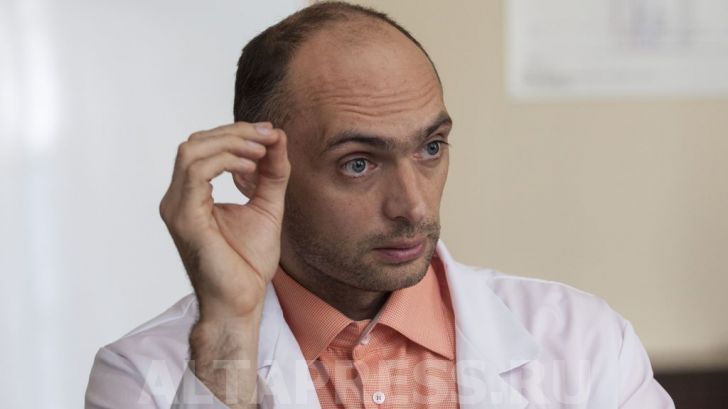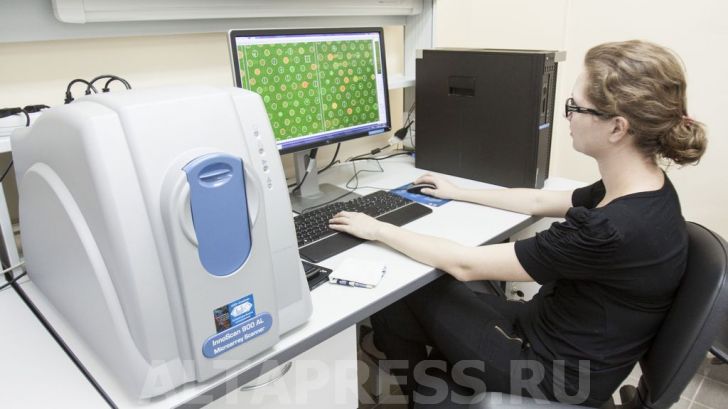Interview with director of Scientific and Research Institute of Biomedicine I.V. Smirnov
What does a person need? To live longer
– One year has passed since the institute started working. Can we now say that the establishment was reasonable and not far-fetched?
 – Year is short period of time, but it’s exactly the time when it is worth asking the question: should we continue working and spend more time, resources and efforts? Our main applied objective is the development of medicines for curing different diseases. From this point of view, the establishment of the institute was definitely reasonable.
– Year is short period of time, but it’s exactly the time when it is worth asking the question: should we continue working and spend more time, resources and efforts? Our main applied objective is the development of medicines for curing different diseases. From this point of view, the establishment of the institute was definitely reasonable.
As for being far-fetched, I would rather say no, it wasn’t far-fetched. There was no department in ASU that would deal with our objectives before the institute’s opening. It was a matter of course: we were negotiating, developing research programs, buying the necessary equipment, shaping our team.
– What key results has the institute achieved?
– To answer this question we need to divide our work into two parts. The first part includes projects that had been developed for years, but were given a push, as there appeared technical opportunities. We have achieved some success: the patents for developed substances and synthesis methods are being obtained; the main stages of preclinical studies have been completed. The second part is projects that we have started here from nothing. Currently, we are at the synthesis stage of molecules ready for testing. Preclinical study results will be ready in about two years.
– Drugs against what diseases do you develop?
– We follow two directions. First one is about developing the remedies against noncommunicable diseases. We develop drugs for treating chronic cardiac failure, inflammatory disorder. We also work on a medicine that has anti-inflammatory, antipyretic and analgesic effect, but doesn’t cause any adverse reaction like other modern drugs, and is also cheap to produce. Moreover, there is a remedy against diabetes complications among our recent developments. Of course, scientists have already learnt how to control the insulin level, but it doesn’t solve the complications problem: diabetic foot, angiopathy, nephropathy, etc. We also work on creation of hepaprotectors – medicines for liver recovery. We are currently developing an immunomodulatory agent, but we have started this project only a short time ago.
The second direction deals with regenerative medicine. Here we develop medicines for treating degenerative diseases, as well as the medical products for active ageing and life prolongation. Today the world spends millions of dollars for solving the ageing problems. Some try to develop biologically active supplements, others – functional nutrition or cosmetics, new technologies are being created. But we have an objective to handle the situation fundamentally, find some mechanisms and molecules. We have pharmacological strategy in regenerative medicine, which means acting on stem cells with medical products.
– Struggle against ageing is an area on the brink of medical science and philosophy. Why did you choose it?
– It is more of a scientific area today. Great number of institutes and laboratories are working hard to solve this problem. What can people worry about if they have already obtained all technological blessings: excellent cars, good nutrition, comfortable living conditions? What do they need? To live longer.
2-3 years instead of 20
– Novosibirsk and Tomsk are admitted scientific centers of Siberia, and the establishment of such institute would be awaited there. But here we see Altai Krai claiming to equitable participation in high-level developments. Is it a breakthrough solution for our region?
– Even more, Altai Krai have already achieved some results in this area. Of course, the institute was not founded out of the blue. Drug development requires material resources and highly-qualified scientists. It was difficult to invite here a whole group of scientists capable of carrying out all research stages and having experience in it. We already had such group in the region, it had been working under my supervision for a long time. Then there was no such equipment as we have today, so we had to work on our project jointly with other universities – four research organizations of Tomsk. Moreover, I was working at Altai State Medical University.
Today our institute’s equipment allows us to create medicines by using modern technologies. Not the old-fashioned way, when 20 years could be spent for invention of one product: scientists were choosing a needed molecule that was more or less safe and effective but had side effects. Modern technologies enable us to reduce the time of development to 2-3 years.
– The time of development and introduction of the medicines is claimed to be one of the key problems. You have already said that the institute will have reach tangible results by 2018.
– It is essential to say that we undertake commitments in our segment. Drugs development consists of two main stages. First stage is preclinical development that involves no human subject research. This part, from idea to producing the material substance, pills, injections, is our responsibility and we will it done by 2018. The stage of human subject testing is on clinics. It happens that a clinic receives three molecules, but only one turns out to be really successful. Clinical testing is a responsibility of industrial partners – the country’s pharmaceutical companies that receive the right for project implementation. They have financial resources to conduct quite costly research, where many major clinics must participate. And here the time can’t be reduced – from 5 years.
Both in the times of ancient Egypt and these days
– Nevertheless, the drugs that you develop will enter the market in 5 years, at the soonest. Don’t you have concerns that the range of existing diseases may change?
– If fact, people did not change that much over the thousands of years. We know that some diseases will not disappear in 5 years, because the medication problem has not been solved yet. Inflammatory processes used to exist in the times of ancient Egypt and they still exist these days. I don’t know a person who has never taken any painkillers or anti-inflammatory drugs. Everyone has tried analgin, aspirin and paracetamol at least once.
Many drugs have a lot of side effects, but they are still in use, because there are no alternatives. For example, there is a great number of people suffering from cardiac failure. They take medicines in vast numbers every day and have to do it throughout their whole life. The same situation is with diabetes. If we don’t create some new safe effective drug, people will continue to suffer from side effects.
 – Side effects are a well-known fact, there are hundreds of laboratories in the world that try to solve the problem, just like you do. Why do people still take aspirin and paracetamol?
– Side effects are a well-known fact, there are hundreds of laboratories in the world that try to solve the problem, just like you do. Why do people still take aspirin and paracetamol?
– Firstly, the problem has not been worked on for that long. Secondly, newly developed medicines, which exist on the market, are very expensive. Our objective is to find innovative, but cheaper and safer substances.
– Is this a feasible objective?
– Of course, it is. Why are the drugs so expensive? Companies spend a lot of time and resources for developing them and they want the costs to be repaid. While the drugs are patented, they will remain so expensive. As soon as the patent expires, generic drugs will be put out and they will cost less. But they still will not be generally available. If we manage to create a medicine identical in effect, then, firstly, it will be home-produced, which is a matter of the country’s pharmaceutical security, and, secondly, it will solve an economic question.
Special question
– Why was Altai State University chosen to be a base for the institute and not, say, medical university?
– Even before the establishment of the institute, Altai State University was well developed in terms of biology, which includes both bioengineering and biotechnology. Chemistry is also developed here. It is not the only example of establishing such institute in a classical university. There are identical departments in the universities of Kazan, Moscow and other cities. Classical university as a base is not less reasonable. I even know an example of the identical institute, even of a bigger scale, working on the premises of a technical university – Moscow Institute of Physics and Technology. Biopharmaceutical cluster was created on its basis. We cooperate with this institute in drug development, by the way.
Other matters
About having more than one higher education degree
– I encourage my employees to get several higher education degrees in every possible way. Drugs development is a complex process. The more knowledge you have, the better you see the problem. Of course, every one of us has their own base speciality. Some of my employees are economists, and it is right. A developer must understand the extent in which the development might be relevant and the potential production level.
About the number of employees
– If we take into account all members of our team, even those who live in other regions, then we’ll have more than 30 employees in total. It’s a very small number. We need at least twice as many workers. Our equipment allows us to do that, the scale of our objectives grows. We have many ideas: sometimes an interesting idea comes up to mind in the course of development of one product, and it is possible to branch off and create another one, so it’s too bad we have to lay it aside. It is particularly relevant to regenerative medicine, it is moving forward at a stunning pace. That is why we have a science club under the Scientific and Research Institute, where any schooler or student can participate. Our youngest participant is the 9th grade pupil, who has already been practicing regenerative medicine and has an idea how to regenerate the injured limbs.